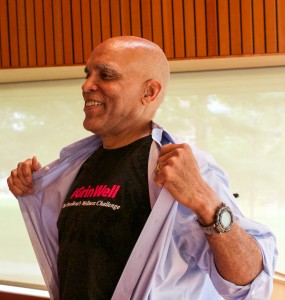On Wednesday, Sept. 17, President Raynard Kington spoke to a group of students, faculty and staff in JRC 101 with a positive and optimistic approach to Grinnell’s future in the first convocation speech of the semester. President Kington’s speech, which was titled “Grinnell at the Higher Education Crossroads,” covered multiple points of interest concerning Grinnell’s past, present and future.
Kington began by discussing rankings and pointed out that Grinnell was listed as the second most economically diverse college by The New York Times, while also ranking high in general rankings.

Photo by Sarah Ruiz
During his speech, Kington seemed pleased with the College’s ability to rank highly in both access and academics, noting that Grinnell has doubled its applicant pool over the past several years and received over 6,000 applicants this past year, allowing the school to shape the class as it wished.
“We attracted more applicants and they were very strong applicants and diverse, so that was a pretty remarkable achievement,” Kington said.
Recently discovered collegiate rankings from 1911—the first year the federal government ranked higher education—placed Grinnell as an elite school, but Kington pointed out that many of the schools on the list then are no longer. He used that piece of information as a lesson.
“We’ve been lucky that we were at the top then and we’re still at the top in lots of ways. It doesn’t just happen,” he said. “You have to make sure you’re continuing to think about how you can be a first-rate institution.”
Kington also said he was proud of the fact that, unlike most schools, there is no difference in graduation rates among students at the lower end of the socioeconomic scale and those at the top. However, there still remains a small gap in completion rates among racial groups, with African-Americans graduating at a slightly lower percentage.
“We’ve narrowed the gap, but we haven’t eliminated the gap and I think that’s unacceptable,” Kington said.
Additionally, Kington noted that although discussing how the school can attract prospective students can be uncomfortable and although marketing the school seems “dirty,” he sees no other option.
“The reality is we have to,” Kington said. “We have to think about how we explain who we are to prospective students.”
Kington then revealed that the school will continue to have town halls this semester, with the first one focusing on the issue of health and accessibility for disabled persons on campus.
Kington added that RLC Autumn Wilke will now assume an additional role as the Coordinator of Disability and Resources.
After last year, during which accessibility on campus was a troubling topic, Eliana Schechter ’17 was relieved to hear that it seemed Kington was paying closer attention to the issue.
“I would assume that if they’re actually putting together a group to work on accessibility in terms of physical disabilities and non-visible ones in addition to reshaping SHACs, I feel like they’re now working towards fixing things,” she said.
After looking into the state of students at Grinnell, Kington moved on to his second point: faculty.
When visiting alumni across the country over the past year, Kington noticed that Grinnellians’ most vivid memories come from experiences working with specific faculty. “We have to work hard to make sure that we can recruit and retain the very best faculty,” he said.
He noted that recruiting high-quality students will help retain faculty because “great faculty like teaching great students,” but the school is also taking other measures to bring in great professors.
Kington said the school has made an effort over the past several years to raise faculty salaries so they approach those of Grinnell’s peer institutions. Additionally, the College is attempting to teach in new ways. Specifically, Kington noted the Innovation Fund: money that is awarded each year for novel approaches to scholarship.
He also discussed programs such as global education and internships. He announced that the school will be launching a pilot internship program in India, which was made possible by alumni who live in the area.
Kington also acknowledged the Finkelman gift, given by Patricia Jipp Finkelman ’80, a Trustee of the College, and her husband, Daniel Finkelman ’77, that will pay for the Dean of the Center for Careers, Life and Service, which will free up funds that can be used to increase staffing and allow for more student opportunities.
Kington’s fourth point concerned facilities. He announced that after a yearlong process of visiting schools across the country and using knowledge from constructing Noyce and experimental classrooms in ARH, the Board of Trustees authorized the school to renovate and expand ARH and Carnegie “into a top line teaching facility for the humanities and social studies.” The College now needs to raise 20 million dollars for the project.
Lastly, Kington announced that he is starting a new presidential initiative, called GrinWell, to promote wellness among students with the idea being that students continue healthy habits after graduation.
To a chorus of laughter, Kington not-so-subtly pointed out that he’s noticed that many alumni are not in the same shape as they were in college, and he wants to change that. The initiative will be four-pronged: Sleep, Eat, Move and Restore.
To the delight of the crowd—one attendee gasped—Kington announced that he was going to tweet his own progress and at the end of his talk, Kington unbuttoned his shirt to reveal a #GrinWell t-shirt underneath.
“It might seem minimal and kind of trivial, but I can only imagine he will be a fantastic tweeter,” wrote attendee and SGA Vice President for Academic Affairs Gwenna Ihrie ’15 wrote in an email to The S&B.
However, some attendees questioned the practicality of the initiative.
“I think it sounds cool, but I don’t really know how effective it will be,” Schechter said.
The question-and-answer session of convocation revealed some skepticism of Kington’s view on the state of the College, but others found his talk to be refreshing.
“[It] was extremely informative. Students complain about transparency often, but we got an extremely clear picture of what the administration and institution are actually doing behind the scenes,” Ihrie wrote.
Kington’s main point was that Grinnell is trying to stay aware of the big picture in terms of higher education nationally, as well as the school’s own mission and own improvement.
“It’s not inevitable that we stay at the top. It takes work and it should take work,” he said. “The world changes and we have to change with it, while remaining true to our core mission.”























































